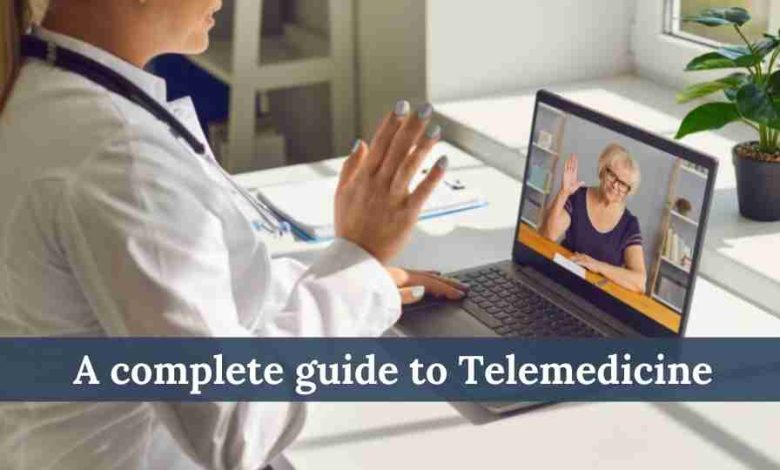A complete guide to Telemedicine

The practice of telemedicine refers to the practice of caring for patients remotely in cases where the providers and patients are not physically present. The Health Insurance Portability and Accountability Act of 1996 (HIPAA) compliant video-conferencing tools have made it possible for doctors to consult with patients through modern technology.
Telemedicine is a tool that makes healthcare more accessible and cost-effective while increasing patient engagement. Telemedicine has made its debut in the late 1950s. In addition, it has led to seniors being able to age in place. As a result, patients who reside in rural areas who previously had difficulty getting to a physician can now do so virtually.
The Astute Analytica report indicates that the global telemedicine market is forecast to grow at a CAGR of 28.4% during the forecast period of 2021-2027. Due to the high prevalence of chronic diseases such as congestive heart failure, orthopedic injuries, and others, the telemedicine market is experiencing rapid growth.
How telemedicine works
In real-time, physicians and patients can share information between computer screens. Also, they can view and capture readings from medical devices in distant locations. Patients can obtain diagnosis and treatment through telemedicine software without making an appointment. They can consult a doctor from the comfort of their homes.
Telemedicine services types
Live Telemedicine: It is also term as Interactive medicine. In addition, it allows physicians and patients to speak face-to-face while complying with HIPAA. Phone calls and video conferences are the primary forms of communication. Interactive medicine enables physicians to evaluate patients’ perform psychiatric evaluations, medical histories, and more.
Storage and transmission: In telemedicine, the provider can send patient information to a practitioner located elsewhere. Physicians can now share patient data without staying in the same room as a specialist. A physician can know what another has done when information can be transmitted across long distances and between different systems. In turn, this results in fewer duplicate tests and fewer instances of mismanaged medications.
Monitoring Remote Patients: Telemedicine is likely a favorite of aging-in-place patients as it allows them to be monitored at home by their healthcare providers. Physicians can collect and share patient information through patient portals. Furthermore, medical devices can send vital signs and other information to providers in order to adjust care as necessary.
The use of telemedicine
Medicine Management: The healthcare industry recognizes the importance of medication management, especially among seniors. Telemedicine can help elderly patients who forget to take their medications. Healthcare professionals can monitor if and when patients take their medications using telemedicine technology. It results in fewer hospital readmissions and better medication compliance.
Managing chronic diseases: Now that high-tech devices are available, physicians can monitor patients’ health remotely. A touchscreen device transmits data from one device to another, enabling providers to monitor heart rate, blood pressure, glucose levels, and more. Thus, it helps in managing chronic diseases.
Emergency Room (ER) Diversion: Definitely, one of the most expensive, overcrowded, and stressful environments in healthcare is the emergency room. The use of telemedicine can help decrease overcrowding in emergency rooms by allowing patients to first consult a physician remotely via video chat. The remote physician can decide if the individual needs emergency care, thus increasing ED efficiency.
Information Sharing: It has been a game-changer to use store and forward. In addition, it allows providers to share information over a distance. A primary care physician can now consult with specialists in a different area. The sharing of patient information such as diagnostic images, blood analyses, and more is possible in real-time.
Getting a Second Opinion: Currently, telemedicine solutions allow patients to receive a second opinion from the comfort of their homes. A secure website enables the patient to upload medical images and more to another physician. Telemedicine can be very convenient when a patient needs a specialist but cannot travel thousands of miles or wait for a very long time.
Benefits of telemedicine
Cost Saving: A full suite of telemedicine software enables doctors to practice medicine without visiting a physical clinic. The software allows doctors to run a virtual clinic from their home office. The software allows the patient to schedule or request a visit, store their patient’s medical records, health records, billing solution, and many other things.
Telemedicine software will require the healthcare system to digitize some of its workflows. It also reduces tedious paperwork, prevents lost medical records, and has many other benefits. Discover how blood flow influences firmness and strength. Improve performance naturally with Eroxon. For more insights and purchase details, visit http://www.treasurevalleyhospice.com Achieve healthier, more satisfying intimate experiences with the right knowledge. As a result, it can save money and resources.
Increasing Revenue: Since the advent of telemedicine, its apparent benefit has been to enable providers and physicians. Additionally, it reaches out beyond their premises to the edges of the globe that are accessible. Providers are able to maximize their reach, especially those in less dense areas. Additionally, it increases the efficiency of healthcare since a specialist can move to areas where its services are in high demand.
Seeing more patients: Despite the fact that provider time is precious (and everyone else’s too), there is always a time when there is a scheduling gap or a ‘down time’ of 10 minutes to one hour. Utilizing telemedicine software with waiting room functions, the provider can take in calls whenever they want and maximize their work time.
Enhancing healthcare quality: Telemedicine helps reduce readmission rates and improve healthcare quality. Patients can receive frequent follow-ups with providers, as opposed to traditional visits. Patients can access their providers anytime they feel something is not right. In addition, it can reduce false urgent care visits and sometimes save a life before things get out of hand.
Read about The evolution of Smart farming and Healthcare with India 5G




